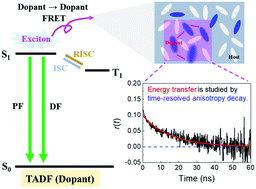Exciton energy transfer and bi-exciton annihilation in the emitting layers of thermally activated delayed fluorescence-based OLEDs†
Abstract
Understanding the exciton energy transfer and bi-exciton annihilation processes in the emitting layers (EMLs) of thermally activated delayed fluorescence (TADF)-based organic light-emitting diodes (OLEDs) is essential for improving their internal quantum efficiency and efficiency roll-off. To study the energy transfer among dopant molecules in EMLs, time-resolved fluorescence (TRF) anisotropy decay measurements were conducted with DPEPO(host):TDBA-DI(dopant) films having different dopant concentrations. Subsequently, the bi-exciton annihilation processes in the DPEPO:TDBA-DI films were studied using time-resolved photoluminescence (TRPL) and excitation power-dependent photoluminescence (PL) experiments. The rate constants for the triplet–triplet annihilation in the films were large at high concentrations of the dopant in the films. The excitation power-dependent PL experiments showed that the laser power threshold for the onset of the bi-exciton annihilation decreased as the dopant concentration increased. Finally, molecular dynamics (MD) simulation and the hybrid Monte Carlo method were applied to understand the energy transfer dynamics at the molecular level. The MD simulation results well supported the results of TRF anisotropy decay measurements. Our current experimental and computational methods can be effectively utilized to understand the exciton dynamics in EMLs, and provide insights into the design of EMLs by optimizing the exciton energy transfer and minimizing undesired bi-exciton annihilation processes in TADF-based OLEDs.

- This article is part of the themed collection: Journal of Materials Chemistry C Lunar New Year collection 2022


 Please wait while we load your content...
Please wait while we load your content...